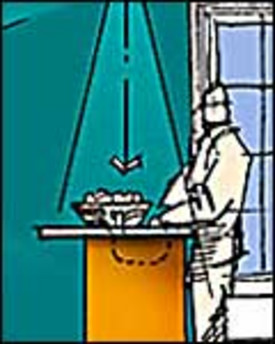Task lighting improves comfort level and safety when you perform tasks that require visual concentration such as food preparation, reading, office work, shaving, and grooming. For it to be effective, however, you must control the amount of light produced, how the light is directed, and glare.
Home Lighting How-Tos
Generally speaking, home lighting is designed with little or no attention to glare and shadows. Unfortunately, both can negatively impact how you perform basic visual tasks. There are a number of tips to remember when you are redesigning a space or planning for needed task lighting.
First, no matter what the basic building package says, general lighting alone will not be sufficient for your kitchen, bath, study, laundry/craft room or office. There are too many visual tasks performed in these rooms. On the flip side, task lighting alone is not comfortable, so plan for a mix of task and general ambient lighting. To do their job well, task lights must emit plentiful, well-diffused light and be placed over the shoulder of the user or to the side of the work area. For kitchen and hobby tasks, downlighting, or using a concentrated light from above, works best.
Three factors determine how much task lighting you will need: the age of the people using the light, the speed and accuracy required for the task, and the reflectance or surface glare involved. Keep in mind that pale surfaces have a higher reflectance than dark ones. So for chopping parsley, it’s best to apply a downlight over a wooden chopping board or matte-finish if you want to keep your fingers!
 |
Kitchen
Since the majority of work in the kitchen is done on the counters, you need to pay particular attention to lighting these surfaces. Locate fixtures near the areas of greatest use and on both sides of the main work area to control glare. Install downlights over the counter 1 to 2 feet from the wall, but avoid putting them over the upper wall cabinets. To minimize shadows, keep the light in front of the person who uses the counter. Use under-cabinet fixtures to light portions of the counter that remain in the shadows.
Bathroom
Let’s face it: We all look at ourselves in the mirror. Given that fact, light should always be directed to the person, not the mirror. To reduce shadows on the face, light should come from both sides of the mirror, not just one. If you do want to use a light over the sink, make sure it’s at least two feet long to avoid casting shadows under your chin, and avoid reflector lamps as they might cast harsh shadows. Wherever possible, use light colored counters to reflect light under the chin. And never place the light source behind the person at the mirror or it will create shadows on the face — a true challenge if you are trying to put on makeup.
Home Office
|
The same principles that apply to a home office will work in any room with a desk. First and foremost, avoid reflected glare and shadows by lighting from the side. Don’t place lamps or windows directly in front of the person at the desk. Instead, put the lamp or natural light source to the left of a right-handed person or to the right of a left-handed person.
Utility Room
Fluorescent bulbs are perfectly suited to utility rooms because they provide plentiful, well diffused and energy-efficient lighting. Task lighting will be required for a sewing machine, ironing board or workbench, and track-mounted systems are ideal for this purpose because the units can be moved to highlight portions of the work. Just make sure the tracks are easy to operate and that the housings have plenty of clearance to swivel in all directions. Also, keep in mind that tasks that are illuminated from the front and above are free from distracting shadows, making attention to detail easy and enjoyable.
Credit: Renovate Your World





























